The Digital Textile Printer Market is estimated to be valued at USD 2667.9 million in 2025 and is projected to reach USD 6795.0 million by 2035, registering a compound annual growth rate (CAGR) of 9.8% over the forecast period.
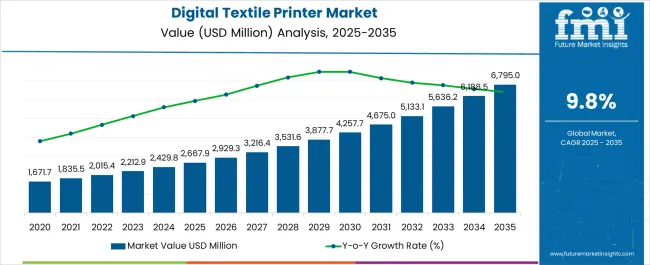
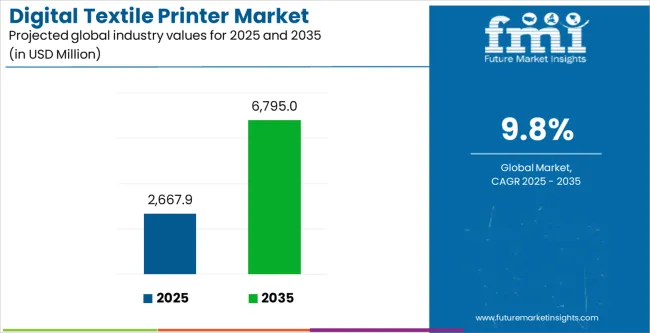
| Metric | Value |
|---|---|
| Digital Textile Printer Market Estimated Value in (2025 E) | USD 2667.9 million |
| Digital Textile Printer Market Forecast Value in (2035 F) | USD 6795.0 million |
| Forecast CAGR (2025 to 2035) | 9.8% |
The digital textile printer market is experiencing robust expansion driven by rising demand for sustainable printing technologies, rapid design customization, and shorter turnaround times in the fashion and home décor sectors. Growing consumer preference for personalized apparel and on demand production has encouraged manufacturers to adopt advanced digital textile printing solutions.
Environmental regulations aimed at reducing water and chemical usage in conventional textile printing are further accelerating the shift toward digital methods. Advancements in print head technology, software integration, and ink formulations have enhanced print quality, speed, and cost efficiency.
Additionally, the expansion of e commerce and fast fashion has reinforced the demand for versatile, high throughput machines capable of handling varied fabric substrates. With increasing alignment toward circular economy practices and eco friendly inks, the digital textile printer market is expected to maintain strong growth momentum in the coming years.
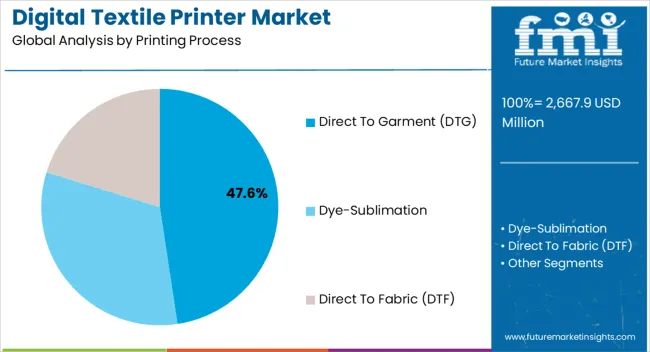
The direct to garment printing process is anticipated to hold 47.60% of total market revenue by 2025, making it the leading process type. Its dominance is supported by the rising popularity of customized apparel and the ability to produce high quality prints directly onto finished garments.
The process enables vibrant colors, detailed designs, and small batch production without requiring complex pre treatment steps. This has made direct to garment printing particularly attractive for fashion brands and e commerce platforms seeking agility and cost efficiency.
Growing adoption across small and medium scale businesses has also reinforced its leadership within the printing process category.
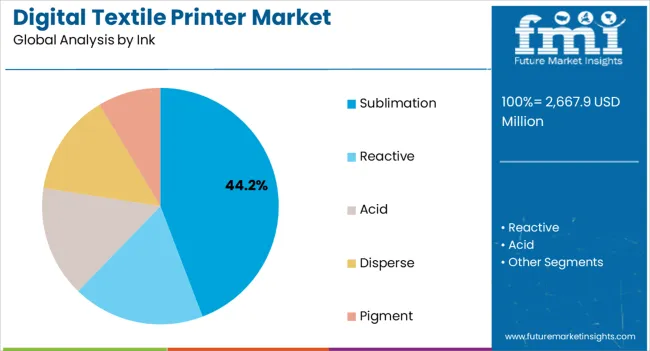
The sublimation ink segment is expected to represent 44.20% of total revenue by 2025 within the ink category, positioning it as the dominant ink type. Its growth is attributed to superior color vibrancy, durability, and wash resistance that meet the requirements of apparel, sportswear, and home furnishing applications.
Sublimation inks have gained traction due to their compatibility with polyester fabrics and their ability to achieve photo realistic results on a wide range of substrates. Furthermore, sustainability benefits including reduced waste and lower water consumption have strengthened their adoption across textile manufacturing.
This balance of performance and eco friendliness has secured sublimation inks a leading position in the market.
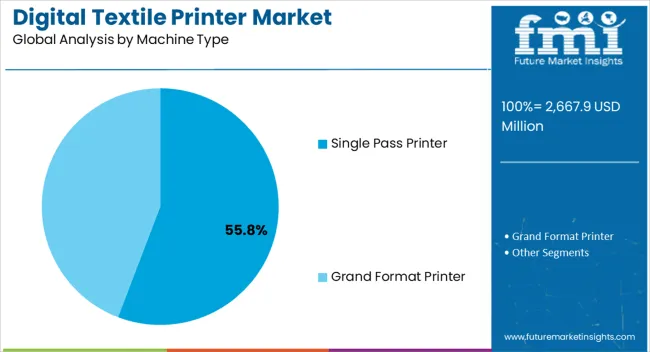
The single pass printer segment is projected to capture 55.80% of total market revenue by 2025 within the machine type category, establishing it as the most significant contributor. This segment’s dominance is driven by its unmatched productivity, with single pass systems capable of printing at industrial scale speeds while maintaining high resolution output.
The efficiency and reduced production cycle times offered by single pass printers align with the requirements of fast fashion and large volume textile producers. Continuous advancements in print head technology and system automation have further reinforced their adoption.
The ability to support diverse fabric types and deliver consistent quality output has positioned single pass printers as the preferred choice for large scale operations, consolidating their leadership within the machine type segment.
The global digital textile printer market exhibited a CAGR of 5.0% during the historic period 2020 to 2025. It attained a valuation of around USD 1,984.5 million at the end of 2025. Looking forward, global sales of digital textile printers are likely to soar at a robust CAGR of 9.8% through 2035.
Digital textile printers perform a specialized form of roll-to-roll wide-format inkjet printing. These printers use inkjet technology for printing print colorants onto fabric, textiles, and garments. This process can be used for printing for small run cycles, single pieces, and also for long run production and it is a great alternative for screen-printed fabric.
Designs can be printed on fabrics or directly on textiles like t-shirts, shirts, jeans, etc. by using digital textile printers. These printers offer numerous advantages over traditional textile printers. These include the ability to produce intricate designs with vibrant colors and the ability to print small runs of customized fabrics without incurring high setup costs.
Sales of digital textile printers are being driven by rapidly shifting fashion trends brought on by an increase in online quick fashion retailers and ongoing fashion trends.
Digital printing offers a greener alternative, coinciding with the industry's rising focus on sustainable practices and minimizing its environmental footprint.
Sustainability is now a key concern in the fashion business. Companies are focusing on developing new technologies and fabric textile machines with advanced features.
Digital textile printers have been advancing rapidly in recent years. New technologies are emerging that enable faster printing, higher resolution, and a wider range of colors and materials.
Digital textile printing empowers designers and brands to create highly customized and personalized fashion products. With digital printers, intricate patterns, vibrant colors, and detailed designs can be easily replicated on fabrics, enabling the production of unique and one-of-a-kind creations.
Usage of digital textile printers quickens the design iteration process, allowing designers to experiment with various patterns, colors, and textures, fostering greater creativity and innovation in fashion design. As a result, made-to-order and bespoke fashion have become viable options, tailoring to individual customer preferences and enhancing the personalized shopping experience.
Digital textile printing eliminates the requirement for large minimum order quantities, making it economically feasible to produce small batches of fashion products. This shift has given rise to on-demand manufacturing, where fashion brands can fulfill garment production only upon receiving orders.
Inventory costs are reduced, and waste is minimized. Advanced capabilities of digital textile printers to accurately reproduce complex and photorealistic designs on fabrics have also played a significant role in driving the market's growth.
The surge in online shopping and the emergence of e-commerce platforms have spurred the desire for personalized textile products.
The seamless integration of digital textile printing with e-commerce platforms allows consumers to conveniently customize and order clothing, home textiles, and other fashion products online. This accessibility and convenience have greatly propelled the widespread adoption of digital printing technology in the digital textile printing market.
E-commerce has created a demand for swift manufacturing and delivery of products. Digital textile printers, renowned for their ability to rapidly print designs and patterns on textiles, are ideally suited to meet these expectations.
The efficiency and speed of digital printing technology align seamlessly with the need for prompt order processing and shipping in the dynamic e-commerce landscape. As a result, businesses operating in the e-commerce sector have increasingly embraced digital textile printers, further contributing to their widespread adoption.
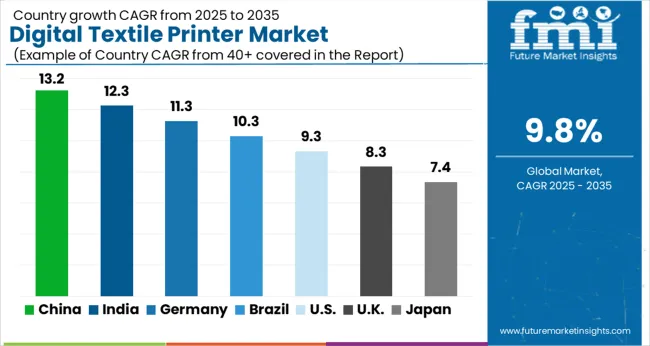
| Country | United States |
|---|---|
| Market Share (2025) | 12.2% |
| Market Share (2035) | 10.7% |
| BPS Analysis | -150 |
| Country | Canada |
|---|---|
| Market Share (2025) | 3.9% |
| Market Share (2035) | 4.1% |
| BPS Analysis | 20 |
| Country | Mexico |
|---|---|
| Market Share (2025) | 2.4% |
| Market Share (2035) | 2.6% |
| BPS Analysis | 20 |
| Country | China |
|---|---|
| Market Share (2025) | 9.3% |
| Market Share (2035) | 7.6% |
| BPS Analysis | -170 |
| Country | Japan |
|---|---|
| Market Share (2025) | 6.4% |
| Market Share (2035) | 5.6% |
| BPS Analysis | -80 |
| Country | Germany |
|---|---|
| Market Share (2025) | 3.7% |
| Market Share (2035) | 3.1% |
| BPS Analysis | -60 |
| Country | United Kingdom |
|---|---|
| Market Share (2025) | 2.6% |
| Market Share (2035) | 2.3% |
| BPS Analysis | -30 |
| Country | Austria |
|---|---|
| Market Share (2025) | 2.2% |
| Market Share (2035) | 2.4% |
| BPS Analysis | 10 |
| Country | India |
|---|---|
| Market Share (2025) | 4.7% |
| Market Share (2035) | 4.3% |
| BPS Analysis | -40 |
Booming Textile & Apparel Sector Propelling Digital Textile Demand in India
India is emerging as a highly lucrative market for digital textile printer manufacturers owing to the flourishing textile & apparel sector. The future of the textile sector in India appears promising, supported by growing domestic consumption and export growth. Further, the Indian government is taking initiatives to bolster the textile sector.
According to the India Brand Equity Foundation (IBEF), the textile and apparel sector in India is expected to reach a value of around USD 2667.9 billion by 2025-26. The country holds a 4% share of the global trade in textiles and apparel.
As of January 2025, exports of readymade garments cotton, including accessories, amounted to USD 2667.9 billion. In June 2025, Mr. Piyush Goyal, the Minister of Textiles, Commerce, and Industry, Consumer Affairs & Food and Public Distribution, announced the government's ambition to establish 75 textile hubs across the country.
Thanks to booming textile & apparel sector and rising export, India digital printer market is anticipated to offer an incremental opportunity of USD 6795 million through 2035. Total digital textile printer demand in India is likely to rise at 8.8% CAGR over the projection period.
Rising Export of Textiles & Apparels Making the United States a Dominant Market
The textile sector in the United States has experienced significant growth in production and exports, solidifying its position as a global fashion design hub with cities like New York, Los Angeles, and Miami hosting prestigious fashion weeks and fostering creativity and innovation.
The United States fashion retail sector is highly competitive, encompassing a wide range of brands spanning from high-end luxury to fast fashion and e-commerce players. This dynamic sector is shaped by shifting consumer preferences, digitalization, and the increasing prominence of online shopping.
As per the National Council of Textile Organizations (NCTO), the total value of United States textile and apparel shipments reached USD 65.8 billion in 2025, securing its position as the third leading exporter of textile products globally. In 2024, the combined exports of fibers, textiles, and apparel amounted to USD 34 billion.
The United States textile sector also plays a vital role in supplying over 8000 textile products to the United States military. Further, the United States textile sector has made substantial investments of USD 20.9 billion in new plants and equipment between 2012 and 2024.
Recent expansions across the production chain include the establishment of recycling facilities to convert textile waste into new textiles and resins. These developments in the United States textile and apparel sector are expected to drive demand for digital textile printers.
According to Future Market Insights’ (FMI) latest report, the United States is estimated to account for around 12.2% market share in 2025. It is likely to exhibit a CAGR of 8.2% during the next ten years.
Versatility of Printing on Different Kinds of Fabric Pushing Sales of Grand Format Printers
Grand format digital textile printers are mostly used in the printing sector as they are faster and more efficient than single-pass printers, and can easily print materials that are too big.
Grand format printers often come installed with piezo technology and multiple print heads that can use multiple types of inks such as acid, reactive, disperse, and pigment inks for printing.
Such printers can print on multiple fabrics such as cotton, polyester, rayon, etc. As per the latest report, the grand format printer segment is expected to hold a dominant market share of over 61.6% in 2025.
Single-pass printer segment on the other hand is expected to thrive at a higher CAGR of 10.8% over the forecast period. This is due to its rising applications across various sectors.
Clothing & Apparel Segment to Lead Demand Due to Increase in Online Fast Fashion Companies
Clothing & apparel segment holds a prominent market share of the digital textile printer industry. Growing demand for trendy clothes & textiles is a key factor driving growth of the target segment.
The increase in online fast fashion companies due to fast-changing fashion trends is creating a high demand for clothing and apparel. This in turn is encouraging the adoption of digital textile printers.
The advanced capabilities of digital textile printers to reproduce photorealistic and complex designs on fabrics are as per consumer demands and fashion trends. As a result, digital textile printers are widely used in printing clothes and apparel.
According to Future Market Insights (FMI), clothing and apparel segment will retain its dominance in the market with a share of more than 64.6% in 2025. It is anticipated to create an incremental opportunity worth USD 2,193.6 million during the forecast period.
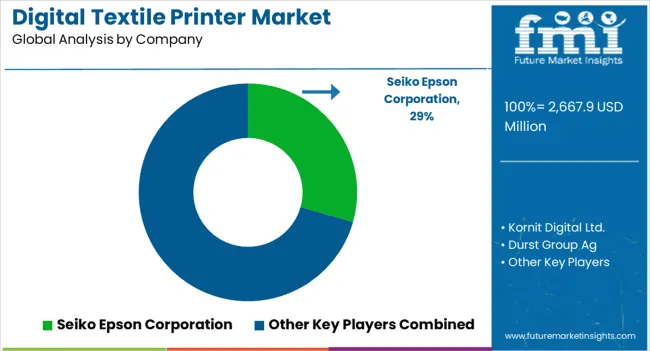
Leading digital textile printer manufacturers are introducing advanced digital textile printing machines to meet end user requirements. They are also focusing on adopting strategies such as mergers, facility expansions, acquisitions, and collaborations to expand their reach and improve revenues.
Recent developments:
| Attribute | Details |
|---|---|
| Estimated Market Value (2025) | USD 2,212.9 million |
| Projected Market Value (2035) | USD 5,304.3 million |
| Anticipated Growth Rate (2025 to 2035) | 9.8% CAGR |
| Historical Data | 2020 to 2025 |
| Forecast Period | 2025 to 2035 |
| Quantitative Units | Revenue in USD Million, Volume in Units and CAGR from 2025 to 2035 |
| Report Coverage | Revenue Forecast, Volume Forecast, Company Ranking, Competitive Landscape, Growth Factors, Trends and Pricing Analysis |
| Segments Covered | Printing Process, Ink, Machine Type, Substrate, Sales Channel, End Use, Region |
| Key Countries Covered | North America, Latin America, East Asia, South Asia & Pacific, Western Europe, Eastern Europe, Central Asia, Russia & Belarus, Balkan Countries, Baltic Countries, Middle East & Africa |
| Key Companies Profiled | Seiko Epson Corporation; Kornit Digital Ltd.; Durst Group Ag; Aeoon Technologies GmbH; J. Zimmer Maschinenbau GmbH; SPGPrints BV; Ricoh Company, Ltd; ATP COLOR S.R.L; Electronics For Imaging, Inc.; DCC Group; MIMAKI ENGINEERING CO., LTD.; Konica Minolta, Inc.; Mutoh Holdings Co. Ltd.; Dover Corporation; HP Inc.; Brother International Corporation; M&R Companies; ROQ Group; Sawgrass Technologies; Colourjet Group; Jakob Müller Group; ROLAND DGA CORPORATION; Hangzhou Honghua Digital Technology Co., Ltd. |
The global digital textile printer market is estimated to be valued at USD 2,667.9 million in 2025.
The market size for the digital textile printer market is projected to reach USD 6,795.0 million by 2035.
The digital textile printer market is expected to grow at a 9.8% CAGR between 2025 and 2035.
The key product types in digital textile printer market are direct to garment (dtg), dye-sublimation and direct to fabric (dtf).
In terms of ink, sublimation segment to command 44.2% share in the digital textile printer market in 2025.






Our Research Products

The "Full Research Suite" delivers actionable market intel, deep dives on markets or technologies, so clients act faster, cut risk, and unlock growth.

The Leaderboard benchmarks and ranks top vendors, classifying them as Established Leaders, Leading Challengers, or Disruptors & Challengers.

Locates where complements amplify value and substitutes erode it, forecasting net impact by horizon

We deliver granular, decision-grade intel: market sizing, 5-year forecasts, pricing, adoption, usage, revenue, and operational KPIs—plus competitor tracking, regulation, and value chains—across 60 countries broadly.

Spot the shifts before they hit your P&L. We track inflection points, adoption curves, pricing moves, and ecosystem plays to show where demand is heading, why it is changing, and what to do next across high-growth markets and disruptive tech

Real-time reads of user behavior. We track shifting priorities, perceptions of today’s and next-gen services, and provider experience, then pace how fast tech moves from trial to adoption, blending buyer, consumer, and channel inputs with social signals (#WhySwitch, #UX).

Partner with our analyst team to build a custom report designed around your business priorities. From analysing market trends to assessing competitors or crafting bespoke datasets, we tailor insights to your needs.
Supplier Intelligence
Discovery & Profiling
Capacity & Footprint
Performance & Risk
Compliance & Governance
Commercial Readiness
Who Supplies Whom
Scorecards & Shortlists
Playbooks & Docs
Category Intelligence
Definition & Scope
Demand & Use Cases
Cost Drivers
Market Structure
Supply Chain Map
Trade & Policy
Operating Norms
Deliverables
Buyer Intelligence
Account Basics
Spend & Scope
Procurement Model
Vendor Requirements
Terms & Policies
Entry Strategy
Pain Points & Triggers
Outputs
Pricing Analysis
Benchmarks
Trends
Should-Cost
Indexation
Landed Cost
Commercial Terms
Deliverables
Brand Analysis
Positioning & Value Prop
Share & Presence
Customer Evidence
Go-to-Market
Digital & Reputation
Compliance & Trust
KPIs & Gaps
Outputs
Full Research Suite comprises of:
Market outlook & trends analysis
Interviews & case studies
Strategic recommendations
Vendor profiles & capabilities analysis
5-year forecasts
8 regions and 60+ country-level data splits
Market segment data splits
12 months of continuous data updates
DELIVERED AS:
PDF EXCEL ONLINE
Oceania Digital Textile Printer Market Size and Share Forecast Outlook 2025 to 2035
Digital Hall Effect Gaussmeter Market Size and Share Forecast Outlook 2025 to 2035
Digital Group Dining Service Market Size and Share Forecast Outlook 2025 to 2035
Digital Pathology Displays Market Size and Share Forecast Outlook 2025 to 2035
Digital Rights Management Market Size and Share Forecast Outlook 2025 to 2035
Digital Liquid Filling Systems Market Size and Share Forecast Outlook 2025 to 2035
Digital Transformation Industry Analysis in MENA Size and Share Forecast Outlook 2025 to 2035
Digital X-Ray Equipment Market Size and Share Forecast Outlook 2025 to 2035
Digital Marketing Analytics Industry Analysis in Latin America Forecast Outlook 2025 to 2035
Digital Health Market Forecast and Outlook 2025 to 2035
Digital Pen Market Forecast and Outlook 2025 to 2035
Digital X-ray Market Size and Share Forecast Outlook 2025 to 2035
Digital Elevation Model Market Size and Share Forecast Outlook 2025 to 2035
Digital Pump Controller Market Size and Share Forecast Outlook 2025 to 2035
Digital Printing Paper Market Size and Share Forecast Outlook 2025 to 2035
Digital Battlefield Market Size and Share Forecast Outlook 2025 to 2035
Digital Product Passport Software Market Size and Share Forecast Outlook 2025 to 2035
Digital Lending Platform Market Size and Share Forecast Outlook 2025 to 2035
Digital Shipyard Market Size and Share Forecast Outlook 2025 to 2035
Digital Freight Matching Market Size and Share Forecast Outlook 2025 to 2035

Thank you!
You will receive an email from our Business Development Manager. Please be sure to check your SPAM/JUNK folder too.
Chat With
MaRIA